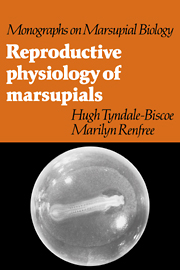Book contents
- Frontmatter
- Contents
- Preface
- 1 Historical introduction
- 2 Breeding biology of marsupials by family
- 3 Sexual differentiation and development
- 4 Male anatomy and spermatogenesis
- 5 The female urogenital tract and oogenesis
- 6 Ovarian function and control
- 7 Pregnancy and parturition
- 8 Lactation
- 9 Neuroendocrine control of seasonal breeding
- 10 Marsupials and the evolution of mammalian reproduction
- References
- Index
1 - Historical introduction
Published online by Cambridge University Press: 06 January 2010
- Frontmatter
- Contents
- Preface
- 1 Historical introduction
- 2 Breeding biology of marsupials by family
- 3 Sexual differentiation and development
- 4 Male anatomy and spermatogenesis
- 5 The female urogenital tract and oogenesis
- 6 Ovarian function and control
- 7 Pregnancy and parturition
- 8 Lactation
- 9 Neuroendocrine control of seasonal breeding
- 10 Marsupials and the evolution of mammalian reproduction
- References
- Index
Summary
Their manner of generation or procreation is exceeding strange and highly worth observing; below the belly the female carries a pouch, into which you may put your hand; inside this pouch are her nipples, and we have found that the young ones grow up in this pouch with the nipples in their mouths. We have seen some young ones lying there, which were only the size of a bean, though at the same time perfectly proportioned, so that it seems certain that they grow there out of the nipples of the mammae, from which they draw their food, until they are grown up and are able to walk.
Francisco Pelsaert from the translation of Heeres (1899)The three sub-classes of living mammals are distinguished most clearly by their modes of reproduction. Many other features set the oviparous Monotremata apart (see Griffiths, 1978) but no other function so distinguishes the Marsupialia from the Eutheria as the manner of their reproduction. This has been recognised since the first marsupials came to the attention of scientists almost 500 years ago and has remained the predominant interest in their study ever since.
Although the original inhabitants of South America and of Australia and the New Guinea islands knew of them, scientific interest began on 8 February 1500 when Vincente Yanez Pinzon collected a female opossum during his first voyage to Brazil. He was so impressed by its pouch and contained young that he took it back to Spain and presented it to King Ferdinand and Queen Isabella at Granada.
- Type
- Chapter
- Information
- Reproductive Physiology of Marsupials , pp. 1 - 13Publisher: Cambridge University PressPrint publication year: 1987
- 1
- Cited by



